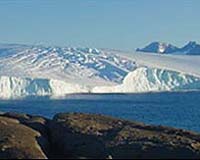| . |  |
. |
Paris (AFP) Aug 13, 2009 Climate, and not the upward thrust of Earth's clashing tectonic plates, is the main factor limiting the height of mountains across the globe, according to a study published Thursday. The forbidding peaks of Mount Everest and K2, in other words, might have been even higher were it not for what scientists call the "buzzsaw" effect of glaciers that form when temperatures stay below a certain threshold. "Glaciers are very effective at destroying mountains," said David Engholm, a researcher at Aarhus University in Denmark and lead author of the study. "Even if you look at the most active mountain ranges, you see that once plate tectonics have pushed them across the snowline altitude, they do not get much higher," he told AFP by phone. The study, published in the British journal Nature, showed that peaks are generally prevented from thrusting more than 1,500 meters (5,000 feet) above the line where snow permanently forms. The findings also explains why none of the world's tallest mountains are found anywhere near the North or South Poles. "The reason is simply that the snowline is higher at lower latitudes than at higher latitudes," Engholm said. At the equator, glaciers do not accumulate before an elevation of 5,000 metres (16,400 feet). In Canada and Norway, or Chile and New Zealand, by contrast, the snowline altitude is as low as 1,000 metres (3,300 feet), he said. Geologists and glaciologists have long debated the mix of factors that determines the height of mountains. All ranges, whether the mighty Himalayas or far humbler peaks, are created from the bottom up when the tectonic plates covering the planet smash against each other. But they are destroyed from the top down by forces that are determined by climate. "Glaciers can keep pace with the most active mountains building that we have on Earth," Engholm said. The idea that massive blocks of moving ice shave off layers from mountain tops is not new, but the study is the first to gather data on all the world's mountain ranges into a single model and check it against mathematical simulations. There are some exceptions: the Transantarctic Mountains, for example, are significantly higher than they should be according to the 1,500-metre-above-the-snowline rule. That is probably because it is so cold at the South Pole that the glaciers are frozen in place and thus do not cause erosion. Another exception are volcanoes, which can accumulate mass faster than glaciers can destroy them. Generally speaking, the older the mountain range, the shorter and flatter it will be. "If given enough time, mountains become very low, such as the Appalachians in the eastern United States," said Egholm. "In Norway, mountains look almost as if they tops had been cut off because very little is left above the snow line -- that is how the term 'glacial buzzsaw' came into play," he said. Share This Article With Planet Earth
Related Links Beyond the Ice Age
 Insight Into Ice Sheet Behavior
Insight Into Ice Sheet BehaviorLondon, UK (SPX) Jul 22, 2009 A new study published this week takes scientists a step further in their quest to understand how Antarctica's vast glaciers will contribute to future sea-level rise. Reporting in the journal Nature Geoscience, scientists from British Antarctic Survey (BAS) and University of Durham describe how a new 3-d map created from radar measurements reveals features in the landscape beneath a vast river of ... read more |
|
| The content herein, unless otherwise known to be public domain, are Copyright 1995-2009 - SpaceDaily. AFP and UPI Wire Stories are copyright Agence France-Presse and United Press International. ESA Portal Reports are copyright European Space Agency. All NASA sourced material is public domain. Additional copyrights may apply in whole or part to other bona fide parties. Advertising does not imply endorsement,agreement or approval of any opinions, statements or information provided by SpaceDaily on any Web page published or hosted by SpaceDaily. Privacy Statement |